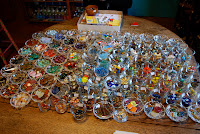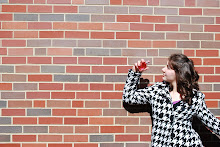I nervously walk behind buildings, across parking lots, finally reaching the sidewalks of uptown Athens. My palms sweat and my heart thuds with each step. Why am I so nervous? I should NOT be this nervous. This is absurd. I continue toward my destination, scuffling through freshly fallen leaves as I contemplate what these next two hours will have in store for me.
By the time I return to reality, my feet are nearly at the doorstep. I softly tap on the glass double doors. I told them I would be here now. Is anyone even here?
A man in his early 20s, wearing a V-neck T-shirt and dark-wash, fitting jeans, notices me and rushes over to let me in.
He opens the door, but walks away. I follow at a distance. Where on earth am I going? And then I realize, This is it.
Somewhere Over the Rainbow
A rainbow of vivid colors surrounds me. I amble through the shop’s ceramic tiles, jewelry, T-shirts, magnets, ornaments, tote bags, baby clothing, mugs, stationery, prints. I feel like a squirrel in a Planters nut factory. And to think, all the artwork was created by artists with mental retardation and developmental disabilities. Unbelievable.
As I continued past the artwork on display, I notice three men huddled over—one drawing, one coloring, one painting.
The man painting sits in silence. With much thought and precision, he dips his foot-long paintbrush into a plastic serving cup filled with robin’s egg blue paint. He pauses, pondering, while a drop of thick, acrylic paint slowly drips onto the paper-covered table. He doesn’t say a word. Concentrating, he hunches, gliding the brush along a beige, faux-leather handbag. His brushstrokes are long and swift.
“Great. There you go,” says Christine Miles with a low, gentle voice. “Nice. Nice job, buddy.”
Miles uses her pointer finger to direct the artist’s next stroke, around large violet circles with golden glitter on top. Another artist added these shapes in the days prior.
“I like the way you’re going around these, Paul,” Miles says to the artist as she traces her finger around each circumference, once again guiding his brushstrokes.
All of a sudden, with one giant swirling motion of the brush, he begins painting over one of the orbs.
“Let’s not paint over the purple circles,” Miles immediately responds, explaining to Paul that another artists worked hard on those violet spheres.
Paul continues around the shapes, every-so-often brushing over part of a circle.
Paul, like many other artists who work at Passion Works Studio in Athens, Ohio, has a developmental disability.
The Beginnings
Passion Works Studio supports collaboration between artists without and with disabilities, whether they are mental or physical. Open since 1998, the studio has let the developmentally disabled express their emotions. It helps “inspire and liberate the human spirit” through their artwork, according to the Passion Works Web site.
The studio started as a three-week residency with artist Patty Mitchell. During those three weeks, Mitchell worked with employees from Atco Inc., a life skills and work training center for developmentally disabled adults, to create an installation of 100 papier-mâché birds to display at the Kennedy Museum of American Art at Ohio University. The next year, the Athens County Board of Developmental Disabilities granted Mitchell a four-month residency, during which she hosted workshops throughout Athens, said Joyce Frank, studio coordinator. The Kennedy Museum again displayed a compilation of the art produced at these workshops.
From these two programs, the Athens County Board of Developmental Disabilities decided to make these residencies year-round, using grant money to fund them; however, once people started buying the art, funding transitioned to product sales, which currently keeps the business thriving. The money from sales also allows Passion Works to hire locals as either visiting artists, who have disabilities, or resident artists such as Miles, Chris Biester and Wendy Minor Viny.
Brought Together Again
Miles has a bachelor’s degree in studio art and a master’s degree in special education. Before working as an artist-in-residence, she taught at a preschool for special needs students. A stint at Passion Works has provided her with the unique opportunity to work alongside some of her former preschoolers, who are now adults, including Jason Licht, a 33-year-old with a long braided ponytail, who uses a motorized wheelchair. When Miles taught Licht in preschool, he was wrapped in a full-body cast and used a skateboard to get around.
“Jason has always had lots to say. Oh, bless your heart, Jason,” Miles said, gently smiling at Licht. “Now he gets to give me all kinds of grief.”
Licht is known to break from the norm of happy and bright drawings and present the dark side of disabilities through his art.
“Why is the art here limited to happy stuff?” asked Licht. “Some of us have pretty debilitating conditions.”
He showed me one of his pieces titled Bad Hare Day, in which a hawk captures a hare mid-jump. Though Licht used bright colors, these are not the typical mixture of blues, greens, pinks and purples. He utilized chestnut brown for the sky, along with a combination of grays, browns and deep greens for the animals and grass. With this piece, Licht aims to display that happiness can be interrupted in a second.
“There is an opportunity for release anytime you have art tools in hand,” said Licht, who tends to draw eagles, hawks and anything intimidating. “We need a creative outlet because if we don’t have these things, we’ll explode.”
And for all you single ladies, Licht said he is available.
It’s a Business
Joyce Frank keeps the business running by ordering supplies, scheduling the artists and organizing projects, marketing and sales. Before receiving a full-time position with Passion Works, she started as a part-time coordinator of community art nights at Atco.
“I like the challenge of never knowing what’s going to happen,” said Frank. “There are always new things to do; there’s never a typical day.”
A Passion Works Vet
Biester—a man in his early 40s with a full, bushy beard and straggly long hair covered by a Montana trucker’s hat—started as a volunteer, and one year later became an artist-in-residence when a full-time position opened.
When he was growing up, his family friend was born with multiple disabilities, and because of this, he always had an interest in working with the disabled. A construction accident in 1993 caused him to spend two weeks on life support in an intensive care unit in Columbus, which contributes to his empathy.
Biester has been exposed to art and music his entire life, and therefore knows no different. He graduated from OU with a degree in art education, though he’s not sure of the year. Working at Passion Works was his first job “totally associated with art,” which adds to the uniqueness of the occupation and causes it to be the perfect fit for him.
“I’m always intrigued by what they can do through art,” said Biester, referring to the limitations the visiting artists overcome when completing each piece. “You live vicariously through your art.”
Each day, Biester enjoys seeing the artists and hearing about what he calls their “adventures.”
Biester emphasized the rareness of working in collaboration with other artists. Miles referred to this aspect as a “layering of talent,” in which multiple artists add their unique flair to each piece. For example, as I observed the artists, Miles pointed to portions of the work and was able to identify artists who participated in the creation. With each layer, the artists-in-residence add definition and shading to enhance the objects. They outline wolves, fish, flowers, birds, bats, houses and skyscrapers with black Sharpie or white paint markers, without changing the visiting artists’ images.
“Stuff happens regularly that’s amazing; everyday is amazing,” Biester said. “Each new accomplishment and victory makes it seem worthwhile.”
* * * * *
Throughout my two hours at Passion Works nearly two weeks ago, I began to realize the effort each artist puts forth in his or her art. Walking out of the studio, my emotions transform, fascinated and happy to sad. I don’t want to leave. Man, I could sit and talk with these artists all day and just watch them work. I never thought about the precision, concentration and patience that goes into every piece. How do they not become frustrated? What goes through their minds? What does a completed piece mean to them? I somehow can’t even imagine what their responses would be. All I do know is that I want to return.
To be awestruck. Impressed. Humbled.

















